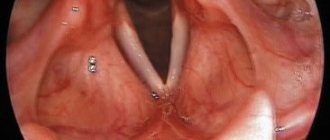Ascites (accumulation of fluid in the abdominal cavity) is detected in 50% of patients in the early stages of cancer and in almost all patients in whom the cancer process is at the last stage.
The Oncology Clinic of the Yusupov Hospital is equipped with the latest diagnostic equipment from the world's leading manufacturers, with the help of which oncologists identify the early stages of oncological pathology. Chemotherapists, radiologists, and oncologists treat patients with ascites in accordance with international standards of medical care. At the same time, doctors take an individual approach to choosing a treatment method for each patient.
Reasons for development
Ascites is a serious complication of stomach and colon cancer, colorectal cancer, malignant tumors of the pancreas, and oncological pathology of the mammary glands, ovaries and uterus. When a large volume of fluid accumulates in the abdominal cavity, intra-abdominal pressure increases, and the diaphragm moves into the chest cavity. This leads to disruption of the heart and lungs. There is a violation of blood circulation in the vessels.
In the presence of ascites, the patient's body loses a large amount of protein. Metabolism is disrupted, heart failure and other imbalances in the internal environment of the body develop, which worsen the course of the underlying disease.
There is always a small amount of fluid in the abdominal cavity of a healthy person. It prevents the sheets of peritoneum from sticking together. The produced intra-abdominal fluid is reabsorbed by the peritoneum.
With the development of cancer, the normal functioning of the body is disrupted. The secretory, resorptive and barrier functions of the peritoneal layers fail. In this case, either excess fluid production or disruption of its absorption processes may be observed. As a result, a large volume of exudate accumulates in the abdominal cavity. It can reach twenty liters.
The main reason for damage to the peritoneum by malignant cells is its close contact with organs that are affected by a cancerous tumor. Ascites in the presence of oncological pathology develops under the influence of the following factors:
- A large accumulation of blood and lymphatic vessels in the peritoneum through which cancer cells spread;
- Tight fit of the folds of the peritoneum to each other, which contributes to the rapid spread of malignant cells to adjacent tissues;
- Germination of a cancerous tumor through the peritoneal tissue;
- Transfer of atypical cells to peritoneal tissue during surgery.
Chemotherapy may be the cause of ascites. The accumulation of fluid in the peritoneum occurs due to cancer intoxication. If the liver is affected by a primary cancerous tumor, metastases of malignant cells from tumors of a different location, the outflow of blood through its venous system is disrupted, and portal hypertension develops - an increase in pressure inside the portal vein. The lumen of the venous vessels increases, plasma sweats from them and accumulates in the abdominal cavity.
The cause of ascites may be peritoneal carcinomatosis. In the presence of a cancerous tumor of the abdominal organs, atypical cells settle on the parietal and visceral sheets of the peritoneum. They block the resorptive function, as a result of which the lymphatic vessels do not cope well with the intended load, and lymph outflow is impaired. Free fluid gradually accumulates in the abdominal cavity. This is the mechanism of development of carcinomatous ascites.
Make an appointment
What complications can follow ascites?
The severity of the underlying disease in the event of ascites reduces the patient’s chances of recovery. The risk of dangerous complications increases even more. These include:
- bacterial peritonitis - infection causes acute inflammation of the peritoneum;
- intestinal obstruction;
- the appearance of hernias in the area of the white line of the abdomen, navel, and groin with possible pinching;
- cardiac decompensation;
- accumulation of fluid between the pleural layers - hydrothorax with acute respiratory failure;
- development of hepatorenal syndrome;
- hemorrhoidal bleeding, prolapse of the lower rectum.
These conditions develop suddenly or gradually and create additional problems in treating the patient.
Stages of severity
There are three stages of abdominal hydrops depending on the amount of accumulated fluid:
- Initial stage - up to one and a half liters of fluid accumulates in the abdominal cavity;
- Moderate ascites - manifested by an increase in the size of the abdomen, edema of the lower extremities. The patient is concerned about severe shortness of breath, heaviness in the abdomen, heartburn, constipation;
- Severe dropsy - from 5 to 20 liters of fluid accumulates in the abdominal cavity. The skin on the abdomen tightens and becomes smooth. Patients experience heart failure and respiratory failure. When the fluid becomes infected, ascites-peritonitis (inflammation of the peritoneal layers) develops.
Best practices
Clinical practice shows that the greatest positive effect is achieved by a combination of 3 treatment methods:
- Cytoreduction is an intervention during which a maximum of cancerous tumors are removed;
- Local hyperthermia;
- Introduction of chemicals into the cavity.
If intraperitoneal hyperthermic chemotherapy (IHC or HIPEC) is used during surgery, it is possible to maintain a significant concentration of the drug in the area of the tumor for a long time and thereby ensure a high medicinal effect. The prospects for such treatment are encouraging.
Intraoperative photodynamic therapy (PDT), with its effect on the tumor with a photosensitizer, is inferior to HIPEC in terms of positive results. This is explained by the fact that the laser does not penetrate all areas of the peritoneum. However, for tumors that are large in volume or tumors that are few in number, this method has proven itself to be excellent.
Symptoms
The main manifestation of ascites is a significant increase in size and pathological bloating of the abdomen. Signs of abdominal dropsy can increase rapidly or over several months. Ascites is manifested by the following clinical symptoms:
- Feeling of fullness in the abdominal cavity;
- Pain in the abdomen and pelvis;
- Increased gas formation (flatulence);
- Belching;
- Heartburn;
- Digestive disorders.
Visually, the patient’s abdomen enlarges, in a horizontal position it hangs down and begins to “blur” on the sides. The navel gradually protrudes more and more, and blood vessels are visible on the stretched skin. As ascites develops, it becomes difficult for the patient to bend over and shortness of breath appears.
Doctors at the Oncology Clinic evaluate the clinical manifestations of the disease and carry out a differential diagnosis of cancer with other diseases, the manifestation of which is ascites.
Stages of pancreatic cancer
After a diagnosis of pancreatic cancer is made, doctors will try to find out the stage. It describes how serious cancer is and how best to treat it. Doctors also use cancer stage when talking about survival statistics.
The earliest stage of pancreatic cancer is stage 0 (carcinoma in situ), followed by stages I (1) to IV. Typically, the lower the number, the less the cancer has spread. A higher number, such as stage IV, means the cancer is in the most advanced stage.
The most commonly used system for pancreatic cancer is the TNM system, which is based on 3 key pieces of information:
Tumor size (T): How big the tumor is and whether it has grown outside the pancreas into nearby blood vessels.
Spread to nearby lymph nodes (N): Whether the cancer has spread to nearby lymph nodes. If yes, how many lymph nodes are affected by cancer.
Spread (metastasis) to distant sites (M): Whether the cancer has spread to distant lymph nodes or distant organs, such as the liver, peritoneum (the lining of the abdomen), lungs, or bones.
Tumor architecture describes how cancer cells look like normal tissue under a microscope.
Level 1 (G1) means the cancer is very similar to normal pancreatic tissue.
Grade 3 (G3) means the cancer appears very abnormal.
Level 2 (G2) is somewhere in the middle.
Low-grade (G1) cancers tend to grow and spread more slowly than high-grade (G3) cancers. In most cases, grade 3 pancreatic cancer has a poor prognosis compared to grade 1 or 2 pancreatic cancer.
Possibility of resection. For patients, an important factor is the size of the resection – whether the entire tumor will be removed:
R0 : The cancer is considered completely removed. (There are no visible or microscopic signs indicating that cancer remains)
R1 : All visible cancer was removed, but laboratory tests of the removed tissue indicate that some small areas of cancer likely remain.
R2 : Some visible tumors could not be removed.
Diagnostics
Doctors identify ascites during an examination of the patient. Oncologists at the Yusupov Hospital conduct a comprehensive examination of patients, which allows them to identify the cause of fluid accumulation in the abdominal cavity. One of the most reliable diagnostic methods is ultrasound. During the procedure, the doctor not only clearly sees the liquid, but also calculates its volume.
In case of ascites, oncologists necessarily perform laparocentesis. After puncturing the anterior abdominal wall, the doctor aspirates fluid from the abdominal cavity and sends it to the laboratory for testing. Computed tomography radiology scans are used to determine the presence of malignant tumors in the liver that cause portal hypertension.
Magnetic resonance imaging makes it possible to determine the amount of accumulated fluid and its location.
Types of edema in cancer
Edema in cancer, or rather edematous syndrome, caused by the release of fluid from the vascular bed and long-term retention in the tissues, can be symmetrical or generalized and local, with a predominant lesion of a separate anatomical part.
The generalized version includes the accumulation of fluid in the internal cavities of the body - ascites or pleurisy, as well as pericarditis - fluid in the lining of the heart.
Such a severe condition of general swelling of the body, such as anasarca, characteristic of terminal heart diseases, is rare in cancer; however, with cancer cachexia, the fatty tissue of a cancer patient can quietly absorb up to 5 liters of “excess” fluid, forming a hidden edematous syndrome. In a person without exhaustion, you can notice an excess accumulation of already 2 liters of interstitial fluid; with widespread cancer and reduced activity, it is very difficult to notice an increase in volume.
Local edema in malignant processes is almost always not of an inflammatory nature, but is caused by a blockage of the outflow of interstitial fluid through the lymphatic vessels.
Stages of leg lymphedema.
Treatment
Drug therapy for ascites is not carried out due to low effectiveness. Aldosterone antagonists and diuretics normalize water-salt metabolism and prevent excess secretion of peritoneal fluid. Oncologists at the Yusupov Hospital offer palliative surgery to patients with ascites in the late stages of cancer:
- Omentohepatophrenopexy;
- Deperitonization;
- Installation of a peritoneovenous shunt.
Doctors at the Oncology Clinic carry out traditional or intracavitary chemotherapy for ascites - after removing the fluid, a chemotherapy drug is injected into the abdominal cavity. Laparocentesis is performed to remove fluid. The procedure is not performed if the following contraindications are present:
- Adhesive process inside the abdominal cavity;
- Severe flatulence;
- Perforation of the intestinal walls;
- Purulent infectious processes.
Laparocentesis is prescribed in cases where taking diuretics does not lead to a positive result. The procedure is also indicated for resistant ascites.
Laparocentesis is carried out in several stages using local anesthesia:
- the patient is in a sitting position, the doctor treats the subsequent puncture site with an antiseptic and administers painkillers;
- An incision is made in the abdominal wall along the linea alba at a distance of 2-3 centimeters below the navel;
- The puncture itself is performed using a trocar using rotational movements. A special flexible tube is attached to the trocar, through which excess fluid is removed from the body. The fluid is pumped out quite slowly, and the doctor constantly monitors the patient’s condition. As the exudate is removed, the nurse tightens the patient's abdomen with a sheet to slowly reduce the pressure in the abdominal cavity;
- After the fluid is pumped out, a sterile bandage is applied to the wound.
Using laparocentesis, up to 10 liters of fluid can be removed from the patient’s body. In this case, it may be necessary to administer albumin and other drugs to prevent the development of renal failure.
If necessary, temporary catheters can be installed in the abdominal cavity, through which excess fluid will gradually be removed. It should be noted that the use of catheters can lead to a decrease in blood pressure and the formation of adhesions.
There are also contraindications to laparocentesis. Among them:
- pronounced flatulence;
- adhesive disease of the abdominal organs;
- stage of recovery after surgery on a ventral hernia.
Diuretics are prescribed to patients with developing ascites in cancer over a long course. Such drugs as Furosemide, Diacarb and Veroshpiron are effective.
When taking diuretics, medications containing potassium must also be prescribed. Otherwise, there is a high probability of developing disturbances in water and electrolyte metabolism.
Dietary nutrition primarily involves reducing the amount of salt consumed, which retains fluid in the body. It is also important to limit the amount of fluid you drink. It is recommended to include more foods containing potassium in your diet.
After removal of fluid from the abdominal cavity, patients are provided with a balanced and high-calorie diet. This allows you to meet the body's needs for proteins, carbohydrates, vitamins and minerals. Fat consumption is reduced.
Diseases that contribute to the occurrence of pathology
Every third patient with gastrointestinal oncology encounters carcinomatosis. Metastases affecting the abdominal cavity may be a consequence of the development of carcinoma of the pancreas and stomach. This happens in about 40% of cases. Another 10% have pathology as a consequence of intestinal cancer. The proportion of patients with ovarian cancer is very high, almost 2/3.
The likelihood of developing a disease is influenced by two main factors:
- Aggressiveness of mutated cells;
- Volume of primary malignant neoplasm.
The causes of the development of pathology, in addition to those listed above, can be tumors of any organ: prostate, lung, breast, etc.
Non-cancerous ascites
Ascites is a consequence of various disorders that occur in the body. Treatment tactics depend on the pathological process that caused the accumulation of fluid in the abdominal cavity:
- To treat acute heart failure, cardiologists at the Yusupov Hospital prescribe metabolites, beta blockers, and ACE inhibitors to patients;
- For infectious and toxic liver lesions, therapy with hepatoprotectors is carried out;
- If ascites has developed due to low protein levels in the blood, albumin infusions are performed;
- Ascites that develops as a result of peritoneal tuberculosis is treated with anti-tuberculosis drugs.
To remove fluid from the body, patients with ascites are prescribed diuretics. The main method of eliminating ascites is to remove accumulated fluid by puncturing the abdominal wall, followed by installing drainage. For persistent ascites, peritoneal fluid is reinfused after filtration. A peritoneovenous shunt for abdominal ascites ensures the flow of fluid into the general bloodstream. To do this, surgeons form a structure with a valve, through which fluid from the abdominal cavity enters the superior vena cava system during inhalation.
Omentohepatophrenopexy for abdominal ascites is performed to reduce pressure in the venous system. The surgeon sutures the omentum to the diaphragm and liver. Then, during breathing movements, the veins are unloaded from blood. As a result, the release of fluid through the vascular wall into the abdominal cavity decreases. As a result of deperitonization (excision of areas of the peritoneum), additional outflow pathways for peritoneal fluid are created.
Tumors of which organs are accompanied by ascites?
The process of accumulation of excess fluid in the abdominal cavity accompanies about half of all cases of ovarian cancer in women. It also complicates the course of neoplasms:
- colon;
- mammary glands;
- stomach;
- pancreas;
- rectum;
- liver.
The severity of the patient’s condition does not depend on whether the primary tumor caused the pathology or its metastasis. The manifestations of cancer are accompanied by signs of increased intra-abdominal pressure, elevation of the diaphragm, and reduction in respiratory movements of the lung tissue. As a result, the conditions for the functioning of the heart and lungs worsen, cardiac and respiratory failure increases, which brings the death of the disease closer.
Forecast
Ascites in cancer significantly worsens the general well-being of the patient. As a rule, such a complication occurs in the later stages of oncology, in which the survival prognosis depends on the nature of the tumor itself and its distribution throughout the body.
Life expectancy with ascites depends on the following factors:
- Functioning of the kidneys and liver;
- Activities of the cardiovascular system;
- The effectiveness of therapy for the underlying disease.
The development of ascites can be prevented by an experienced doctor observing the patient. Doctors at the Yusupov Hospital have extensive experience in dealing with various types of cancer. Qualified medical personnel and the latest equipment allow for accurate diagnosis and high-quality, effective treatment in accordance with European standards.
When to see a doctor
As soon as the first signs of liver cancer appear, you should immediately go to the doctor. If you are looking for a highly qualified oncologist near the Mayakovskaya, Belorusskaya, Novoslobodskaya, Tverskaya or Chekhovskaya metro stations, then we recommend that you contact Oncology. You should understand that treating liver cancer at an early stage will give the best prognosis for recovery. But for these purposes it must be diagnosed.
Therefore, if you have the first signs of liver cancer, hurry to make an appointment with an oncologist. The specialist will conduct all the necessary studies, prescribe a number of specific tests for you and will be able to begin treatment on time if the results of the tests are positive.










